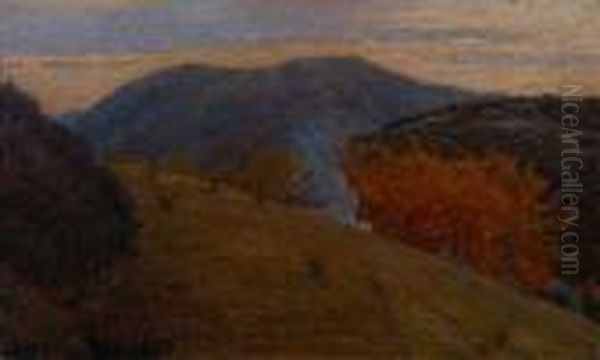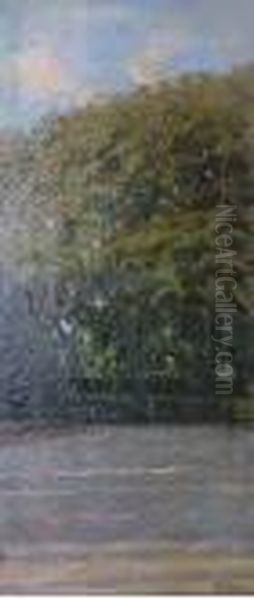Luigi Gioli stands as a significant figure in the landscape of late nineteenth and early twentieth-century Italian art. Born in 1854 and living a long life until 1947, he was an accomplished Italian painter deeply connected to the Tuscan region and a notable member of the influential Macchiaioli movement. His work, primarily focused on landscapes but also encompassing military themes and genre scenes, reflects a unique synthesis of Italian artistic traditions and the burgeoning modern approaches to painting that swept across Europe during his time. Gioli's dedication to capturing the specific light, atmosphere, and daily life of his native Tuscany earned him recognition both within Italy and abroad.
Early Life and Artistic Beginnings
Luigi Gioli entered the world in San Frediano a Settimo, a locality within the province of Pisa, then part of the Piedmont region, in 1854. This area of Tuscany, rich in history and natural beauty, would become a lifelong source of inspiration for his art. He later settled in Florence, the vibrant heart of the Tuscan art world, where he would spend much of his artistic career and eventually pass away in 1947. Florence provided not only a base of operations but also a stimulating environment, placing him amidst the ongoing debates and developments that characterized Italian art during this transformative period.
His artistic journey was closely intertwined with that of his elder brother, Francesco Gioli, who was also a painter. While some early accounts might have initially viewed Luigi's talents as less pronounced compared to his brother's, he steadily developed a distinct artistic personality. Over time, Luigi Gioli came to be recognized for his high degree of cultural literacy and a remarkably consistent and personal style, particularly evident in his sensitive landscape paintings. The influence of Francesco, especially in the realm of landscape painting during Luigi's formative years, was undoubtedly significant, fostering a shared artistic dialogue within the family.
The Macchiaioli Connection

Luigi Gioli emerged as an important participant in the Macchiaioli movement, arguably the most significant Italian contribution to painting in the latter half of the nineteenth century. Originating in Florence around the 1850s and 1860s, centered initially around discussions at the Caffè Michelangiolo, the Macchiaioli sought to break free from the constraints of academic Neoclassicism and Romanticism. Their name, derived from "macchia" meaning "patch" or "spot," referred to their practice of applying paint in bold patches of color and contrasting light and shadow to capture the immediate impression of a subject, often painted outdoors (en plein air).
This revolutionary approach prioritized realism and the direct observation of nature and contemporary life. The Macchiaioli aimed to render the structure and feel of a scene through the truthful depiction of light and color relationships, predating some aspects of French Impressionism. Key figures associated with the movement include pioneers like Giovanni Fattori, Telemaco Signorini, Silvestro Lega, Giuseppe Abbati, and Odoardo Borrani. Luigi Gioli, belonging to a slightly later generation or phase of the movement, absorbed these principles and integrated them into his own artistic vision. His involvement solidified his place within this vital current of Italian modern art, which laid crucial groundwork before the rise of Post-Impressionism in Italy.
Artistic Style: Light, Landscape, and Influence
Gioli's mature artistic style is characterized by a sophisticated blend of influences, filtered through his personal sensibility and deep connection to the Tuscan environment. While firmly rooted in the Macchiaioli emphasis on light and color patches, his work also reveals an awareness of broader European trends, notably French Naturalism and certain aspects of Impressionism. This is visible in his commitment to depicting scenes with objective honesty and his fascination with the transient effects of light on the landscape.
However, Gioli's art remained distinctly Italian, infused with elements drawn from the rich artistic traditions of Tuscany and even echoes of the ancient Etruscan connection to the land. His brushwork, often described as delicate or fine, allowed for nuanced descriptions of form and texture, while his mastery of light and shadow ("chiaroscuro," though adapted to the brighter palette of modern painting) was central to creating mood and defining space. He excelled at capturing the unique luminosity of the Tuscan countryside – the clear sunlight on fields, the dappled shade under olive trees, the hazy atmosphere of midday, or the melancholic light of autumn.
His paintings often evoke a sense of tranquility and profound beauty found in the everyday reality of the Italian countryside. Whether depicting expansive views or more intimate corners of nature, Gioli demonstrated a remarkable ability to translate his observations into compelling visual statements, balancing realistic detail with a painterly handling of the medium.
Themes and Subjects: The Soul of Tuscany

The primary focus of Luigi Gioli's oeuvre was the landscape of Tuscany. He was particularly drawn to the Maremma region, the coastal plains of western Tuscany, and the areas around Florence and Pisa, including the Arno River valley. His landscapes frequently feature horses, often depicted grazing freely or as part of rural labor, rendered with anatomical accuracy and a sense of vitality. These animals become integral elements of the natural scenes, embodying the pastoral spirit of the region.
Beyond pure landscapes, Gioli explored themes related to rural life and agricultural activities. Works like Fiera di vacche (Cow Fair) capture the social and economic rhythms of the countryside. He also ventured into military subjects, a theme popular among Macchiaioli artists like Giovanni Fattori, reflecting the recent history of Italian unification (Risorgimento) and contemporary military life.
While landscape dominated, Gioli also produced genre scenes and studies of figures. His work Bambine tra gli ulivi (Girls Among the Olive Trees) showcases his ability to integrate figures naturally within a landscape setting, capturing a moment of quiet childhood innocence amidst the characteristic Tuscan olive groves. Studies like STUDI DI DONNA CON CESTO Sulla testa (Study of a Woman with a Basket on Her Head) demonstrate his skill in observing and rendering the human form and local customs, revealing an interest in portraiture and the depiction of everyday people. Still life subjects, such as Grapes and Apples, also appear in his body of work, showcasing his versatility and attention to form and texture.
Notable Works and Exhibitions
Luigi Gioli's long career was marked by consistent participation in major national and international exhibitions, which helped establish his reputation. His presence at these events underscores his active role in the Italian art scene.
One of his early international exposures came at the 1889 Paris Exposition Universelle, where he exhibited the painting titled Rorchi. This participation placed his work within the context of global artistic trends at a prestigious venue.
In Italy, he frequently exhibited with the Società di Belle Arti di Firenze (Fine Arts Society of Florence), a key institution for artists in the region. In 1894, he sent two significant works, Nei prati (In the Meadows) and Fiera di vacche (Cow Fair), to an exhibition in Milan, further broadening his national recognition.
A landmark event was his participation in the very first Venice Biennale in 1895. He exhibited the work Novembre (November), a piece likely capturing the specific atmosphere and light of the Tuscan autumn landscape. The Venice Biennale quickly became one of the most important international contemporary art exhibitions, and Gioli's inclusion in its inaugural edition was a notable achievement. He continued to exhibit in Venice, presenting a work titled Meriggio (Midday) at the Venice International Art Exhibition in 1900.
Other known works that exemplify his style and subject matter include CASCINE (likely depicting Florence's Cascine Park), IL TRIBUNALE IN TRINCA (The Court in Trinca), Forest Scene, The Hunt, Grapes and Apples, and Bambine tra gli ulivi. He also participated in exhibitions in Macerata, alongside his brother Francesco, and his works were reportedly sent to the Paris Salon, another major international art showcase.
Contemporaries and Artistic Circle
Luigi Gioli operated within a rich network of artists, primarily centered around Florence and the legacy of the Macchiaioli. His most significant artistic relationship was undoubtedly with his brother, Francesco Gioli. Their shared background and profession likely led to continuous artistic exchange and mutual influence throughout their careers.
As a prominent Macchiaioli painter, Luigi Gioli would have been well-acquainted with the leading figures of the movement, even if some belonged to an earlier generation. These include the aforementioned Giovanni Fattori, known for his military scenes and Maremma landscapes; Telemaco Signorini, a versatile painter and influential writer; Silvestro Lega, celebrated for his intimate domestic scenes; Giuseppe Abbati; Odoardo Borrani; Vincenzo Cabianca; Adriano Cecioni (also a sculptor and critic); Serafino De Tivoli; and Cristiano Banti. These artists collectively shaped the direction of Tuscan painting in the latter half of the 19th century.
Gioli is also known to have collaborated with the artist Ruggero Focardi. While the exact nature of their collaboration isn't detailed in the provided context, such partnerships were not uncommon. Furthermore, the artistic milieu included figures like Sebastiano Gherardi and Giovanni Coli, associated with the art scene in Lucca and connected through the painter Filippo Gherardi. Although Gioli's direct relationship with them isn't specified as mentorship, their presence indicates the interconnectedness of the regional art world. One might also consider Antonio Fontanesi, whose landscape painting influenced the broader Piedmontese and Lombard traditions that interacted with the Macchiaioli, or even Giovanni Boldini, an Italian contemporary who achieved immense fame in Paris with a vastly different, more flamboyant style. Gioli's path remained focused on the Tuscan landscape, contrasting with Boldini's international portraiture.
His active participation in artistic debates and his connections with cultural figures suggest he was an engaged member of the Florentine intellectual community, contributing not just through his canvases but also through dialogue and organizational involvement.
Later Life, Legacy, and Personal Notes
Luigi Gioli remained active in the art world well into the 20th century. His commitment is evidenced by his role on the executive committee for the Florence Modern Art Exhibition in 1920, indicating his respected position among his peers even in his later years. He continued to paint, staying true to his established style while perhaps reflecting the changing artistic climate in subtle ways.
A noteworthy aspect of his personal life, mentioned as somewhat unique for his time and social context, is that Luigi Gioli never married and had no children. He dedicated his life primarily to his art.
He passed away in Florence in 1947 at the age of 93, leaving behind a substantial body of work that documents the landscapes and life of Tuscany with sensitivity and skill. His legacy lies in his contribution to the later phase of the Macchiaioli movement and the broader tradition of Italian landscape painting. He stands as a testament to the enduring appeal of the Tuscan scene and the effectiveness of the Macchiaioli principles in capturing its essence. His works continue to be appreciated for their technical proficiency, atmospheric depth, and honest portrayal of a specific time and place, offering a valuable reference point for understanding the evolution of modern Italian art.
Conclusion
Luigi Gioli was more than just a painter of pleasant scenes; he was a dedicated interpreter of the Tuscan soul and an important voice within the Macchiaioli movement. His ability to synthesize local traditions with modern European artistic currents resulted in a body of work characterized by its lyrical realism, mastery of light, and profound connection to the land. From the sunlit fields of the Maremma to the bustling activity of a country fair, Gioli captured the visual poetry of his region. Through his numerous exhibitions and consistent artistic output, he solidified his place as a respected figure in Italian art history, leaving behind a legacy that continues to resonate with those who appreciate the timeless beauty of the Tuscan landscape rendered with skill and affection.